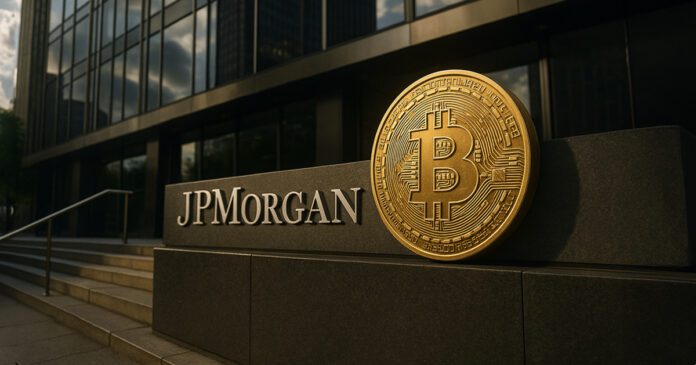After years of tension between crypto and traditional finance, a symbolic shift is taking shape inside the world’s largest bank.
JPMorgan Chase & Co. is reportedly preparing to let institutional clients use Bitcoin and Ethereum as collateral for cash loans. This means the bank’s borrowers can pledge the two top cryptocurrencies by market capitalization, which would be held by approved third-party custodians like Coinbase.
The initiative is expected to roll out by the end of 2025.
This move is significantly ironic considering the financial giant’s CEO Jamie Dimon is a renowned crypto critic. Notably, he has previously described Bitcoin as a “fraud.” However, increased demands for the emerging industry has forced his hands to support these product launches by his firm.
A new chapter for digital collateral
JPMorgan’s move could quietly rewrite the boundaries between digital assets and regulated credit markets.
According to Galaxy Research data, open centralized-finance (CeFi) borrows totaled $17.78 billion as of June 30, up 15% quarter-over-quarter and 147% year-over-year.
When decentralized loans are included, total outstanding collateralized crypto credit reached $53.09 billion in Q2 2025. This is the third-highest figure on record.
These numbers point to a structural shift where borrowing activity rises as digital-asset prices increases. This results in improved credit spreads making loans more attractive for traders and treasuries.
Moreover, corporate firms are also tapping crypto-backed lending to fund operations, replacing equity issuance with secured debt against digital assets.
In that context, JPMorgan’s entry looks less like an experiment and more like a decisive institutional catch-up move in the emerging industry.
Considering this, crypto researcher Shanaka Anslem Perera estimates the model could unlock $10 billion to $20 billion in immediate lending capacity for hedge funds, corporate treasuries, and large asset managers seeking dollar liquidity without selling their tokens.
In practical terms, that means firms can now raise capital against digital assets the same way they would against US Treasuries or blue-chip equities.
Why JPMorgan’s move matters
While crypto-collateralized lending is familiar inside DeFi protocols and smaller CeFi lenders, JPMorgan’s participation institutionalizes the concept.
The bank’s entry signals that digital assets have matured enough to meet global finance’s compliance, custody, and risk-management standards.
Matt Sheffield, the CIO of Ethereum-focused treasury firm SharpLink, believes the development could reshape balance sheet management across asset managers and funds.
According to him:
“Many traditional financial institutions who rely on trading with banks to date need to choose between holding spot ETH OR other positions. The largest investment bank in the world is here to change that. With the ability to borrow against positions held in third-party custodians, you can build a more productive portfolio, increasing the value of the collateral asset. “
Meanwhile, the decision also strengthens JPMorgan’s broader crypto posture. Over the past two years, the bank has built out Onyx, its blockchain-based settlement network, processed billions in tokenized payments, and explored digital-asset repo transactions.
Accepting BTC and ETH as loan collateral completes the loop: issuance, settlement, and credit, all of which touch the blockchain rails.
Considering this, Sheffield predicts the move will trigger a “competitive cascade” among large banks. He noted:
“This starts a wave. Being first is what scares large institutions. The rest will follow with the decision de-risked, because no action would leave them uncompetitive.”
Already, rivals like Citi and Goldman Sachs have expanded digital-asset custody and repo initiatives. BlackRock, meanwhile, has integrated tokenized treasuries (BUIDL) into its fund ecosystem, while Fidelity has doubled its institutional crypto desk headcount this year.
The road ahead
Despite Wall Street’s growing embrace of digital assets, challenges remain.
Banks entering this market must navigate the intrinsic volatility of cryptocurrencies, uncertain regulatory capital treatment, and persistent counterparty risk—all of which constrain how aggressively they can expand crypto-backed lending.
US regulators have yet to issue clear capital-weighting guidelines for digital collateral, leaving institutions to rely on conservative internal models. Even with third-party custodians managing custody risk, supervisory oversight is expected to remain intense.
Still, the trajectory is unmistakable because digital assets are gradually being woven into the fabric of global credit markets.
Bitcoin analyst Joe Consoerti said these moves show that:
“The global financial system is slowly recollateralizing itself around the highest quality asset known to man.”

